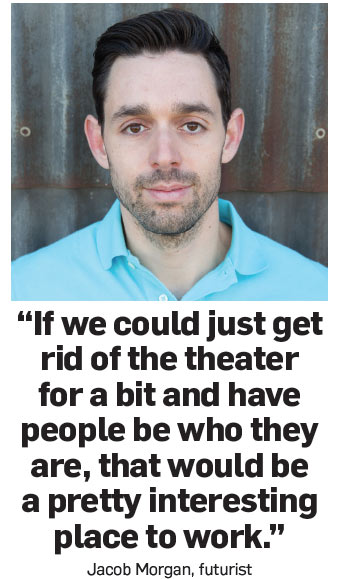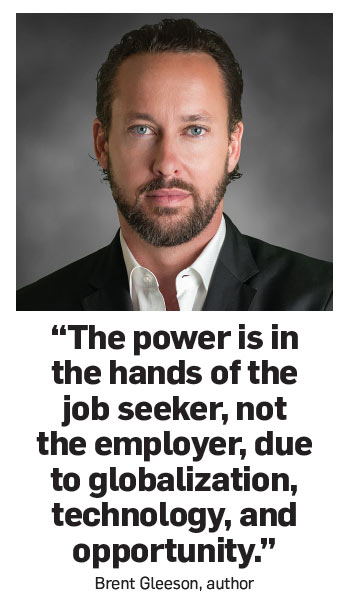November 27, 2017
The Future of Leadership
The best bosses will need to adapt to their employees – not the other way around.
If you ask Jacob Morgan, an author and expert in the future of work, employee mindsets have drastically changed from 10 or 20 years ago. It’s a motivation thing; the previous generation came to work and primarily saw it as a way to provide for their families. Millennials and Generation Z employees? Forget that. They want to have an impact on the world. They want to change things and be creative and really feel a sense of purpose at work.
“I don’t want to make it sound like it’s more selfish, where older employees worked for others and younger workers work for themselves, but it almost seems like there’s a little bit of that in there,” Morgan says. “I don’t want to mischaracterize it as selfless and selfish. But the motivations are different.”
>>Don't Miss! Will Employees Ever Work For A Robot Boss?
And it’s not just the world of employees that has changed. In order to keep up with new generations joining the workforce, leaders need to adapt their management styles and company culture as well. “Executives have to realize that tactics from 20 years ago are just that: 20-year-old tactics,” says Bill Korowitz, CEO at The Magnet Group (asi/68507).
So what will the future of leadership look like as we learn to adapt to these new incoming employees? First and foremost, it’s about learning what millennials and Gen Z (those born in the mid-1990s) employees value – and altering management strategies to meet those needs.
A New Worker
The numbers are staggering: according to recent Gallup polls, only 33% of the workforce in the U.S. is actually engaged in their jobs. That means a loss of more than $550 billion to missed productivity annually. It’s been an ongoing issue, but appears to only be getting worse as new generations enter the workforce. The old methods of keeping employees involved no longer seem successful.
“[The new generation values] their time off and use it for a variety of reasons,” says Jo-an Lantz, EVP at Geiger (asi/202900). “In general they’re both the most plugged in, and plugged off group. They value benefits, collaboration, teams, and aspiring to meet goals that make sense to them.”
Jill Albers, VP of business development at Shumsky (asi/326300), agrees. “They want to know the why behind the tasks they’re being asked to complete,” she says. “They have a desire to understand the bigger picture and overall goals of the organization. This is a fabulous attribute because they’re not only focused on their own success, but the success of the group as a whole.”
Younger generations of employees, says Albers, also embrace teamwork and have an inherent desire to do good. “They want to gain everyone’s feedback on a project. They may feel challenged when decisions are made without their input,” she says. “Reinforcement of the overall goals, insight into decision-making and open communication are all important. Millennials and Gen Zs are immensely charitable and want to give back to the community. Providing flexible hours to do so is a must.”
The Changing Role of Execs
One of the biggest challenges younger generations bring is a need for leaders to alter how they do their job – or else risk losing these valuable employees.
“The power is in the hands of the job seeker, not the employer, due to globalization, technology and opportunity,” says Brent Gleeson, leadership coach and author of TakingPoint. “The workforce cares deeply about culture and the purpose of the organization, understanding how their work is going to matter, more so than ever. It’s a new issue leaders and managers have to deal with because most organizations, even structurally, aren’t set up to be able to handle those needs of this new workforce.”
Gleeson notes this will introduce an important learning curve to the office. Leaders will need to focus on culture, as this is what most jobseekers will initially see thanks to the transparency of employee reviews on sites like Glassdoor, LinkedIn and Indeed. A shift needs to happen in response, where leaders align their company culture with company goals as they recruit and hire based on those strategic visions.
Another major shift for leaders of the new generation of workers is based solely in hierarchy. Basically, it won’t really exist anymore. “Millennials and Gen Z employees don’t care about hierarchy,” Morgan says. “They’ll go talk to anyone. They want things done quicker. They don’t believe in as rigid of a structure. They grew up proponents of workplace flexibility and working anytime, anywhere, on any device.”

Mitch Mounger, CEO at Sunrise Identity (asi/339206), suggests that in order to meet the needs of modern staffers, this kind of flexibility is vital. Managers and senior executives will need to be open to listening to whoever comes to speak to them, and focus on transparency and collaboration. Brandon Mackay, CEO at SnugZ (asi/88060), feels the same way, going so far as to say that leaders should “be more transparent than you’re comfortable with. Highly accessible leadership moving forward is a must. You can’t fake your way through anything; they can sniff out a fraud in a second.”
For Norm Hullinger, CEO at alphabroder (asi/34063), perhaps one of the most important things leaders can do for the new generation is to get them involved and interested in company culture through coaching sessions. This way, they’ll be groomed for success early.
“We try to pull new folks together and foster that relationship where they find someone,” he says. “We assign them mentors and indicate to them that what they really need to do is weave themselves into the fabric of the organization, not just produce or book sales. You’ve got to help them help themselves to take a look around and figure out how to really get inside the organization.”
Above all, though, everyone interviewed believes that being authentic and comfortable with yourself as a leader matter a lot. Emotional intelligence is also key. “People want to know that their leader is just a person like them with a real life,” Albers says. “They will follow a leader that has the best interests of the employees, clients and organization at heart. They want a leader that is genuine and real, even exposing their flaws.”
Agreeing that being “real” is a critical part of being a strong leader, Morgan adds: “You look at all these executives and VPs that run these mega companies. And these people still are silly outside work, they still mess around with their kids, they still go to Disneyland. They’re totally different people outside of work. It’s kind of like a performance when everybody shows up to work, they have to play this character. The CEOs and the VPs have to play the all-powerful character and the employees have to play this subservient character of ‘I’ll do whatever you tell me.’ If we could just get rid of the theater for a bit and have people be who they are, that would be a pretty interesting place to work.”
Judging Work Performance
With changing leadership roles will come new ways to evaluate the success of leaders in the future. No more will it be simply a profit and sales based evaluation.
“Leaders will be judged by the difference they make and how successful they are at achieving the goals they set forth to accomplish,” said Albers. “Profit is important, of course. It ensures jobs and the longevity of the organization, but other factors are also important today. Are they out to change an industry? Are they looking to be drastically innovative? Are they inspiring and training the employees within their organizations to follow by example? I feel establishing a clear set of goals then evaluating progress toward those goals will be the measurement of success.”

Mackay, meanwhile, believes culture will become a big part of the evaluation process. Productivity, innovation and process improvement spikes in a creative and open culture, he says, and these are things leaders will be judged on.
Upward mobility of employees will also become a great indicator of how an executive is doing within the company. “One of the most important criteria we can have for a manager is how successful they make other people on their team,” Morgan says. “Can that be used as a metric to evaluate success? Do managers help make other people more successful than they are? What happens to the people that you manage? Where do they go, what roles do they end up taking? If you can help make other people more successful, that’s a sign of a really great manager.”
The process of gauging success will change as well, Gleeson says. Constant and brutally transparent feedback will become critical, not just on the employee side, but for leaders as well, he adds. Presently, most companies ask for feedback on leadership performance and then employees never hear about it again. But especially for senior leaders, Gleeson says, it’s important to not only provide regular feedback to employees, but to hear what they’re saying and act on it as well. And that will be the mark of a true leader of the future.
“It’s got to be part of the culture otherwise people won’t do it, they’ll just keep their mouths shut and gossip about senior leaders behind their back,” he says. “If I, as a senior leader, lead by example in that regard, the people below me are going to be more accepting of my feedback. If I’m accepting of that feedback and I bring it 360 by saying what I’m going to do to improve and I’m going to hold myself accountable, then it’s going to become part of the culture and everyone will take it in stride and be more accepting of feedback.”
Email: jennifer@jenniferbillock.com